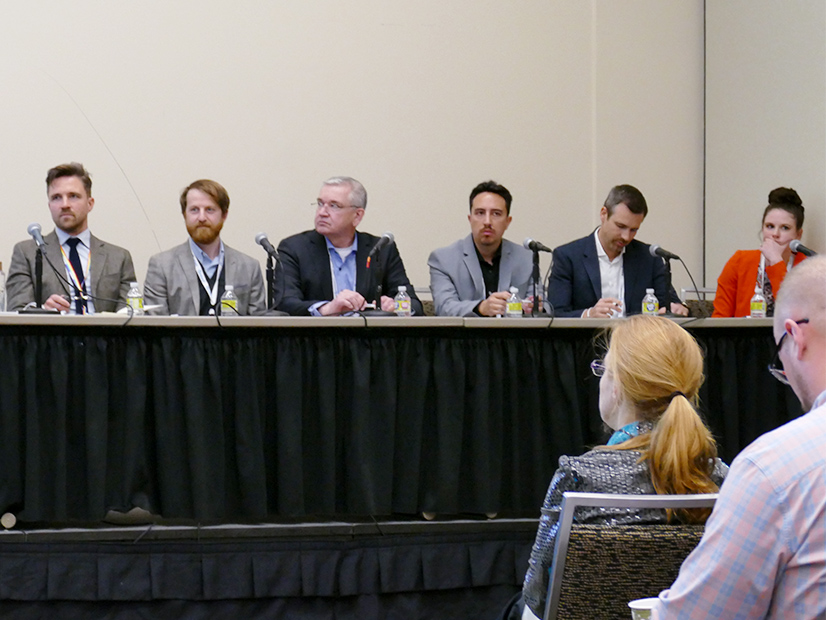
BALTIMORE — The first U.S. wind farms are being connected to the grid with one-off radial transmission lines, but as the industry grows it will have to follow Europe’s recent example and build out meshed high voltage, direct current (HVDC) systems, experts told the Business Network for Offshore Wind’s International Partnering Forum last week.
“Why are we thinking about doing this?” asked Judy Chang, a fellow at Harvard’s Kennedy School. “Overall savings, reliability, resilience, maximizing the integration of renewables while strengthening the grid through offshore systems.”
The Elia Group, which runs the grid in Belgium and eastern Germany, last year created a new subsidiary called WindGrid to pursue such offshore transmission opportunities.
Having an independent set of eyes looking at the infrastructure needed to connect offshore wind farms has worked well in Europe and now Elia’s new unit is starting to bring that business to the United States market, said WindGrid CEO Markus Laukamp. One of the big challenges in the U.S. is that transmission planning and generation develop at the same time in parallel tracks. That makes it hard to build out the transmission system, which takes longer to complete, he said.
“I think one of the challenges that we see for the U.S. is really to get these things in order so that maybe not next year — maybe five to 10 years — you can do things in the way that makes the most sense for the ratepayer and that is optimizing a coordinated grid,” Laukamp said.
New York is hoping to start planning a meshed offshore grid in tandem with its upcoming wind procurements, said Georges Sassine, vice president of the New York State Energy Research & Development Authority.
Sassine said he has been urging NYISO to run a public policy transmission planning process under Order 1000 to help bring renewable power into New York City both from on and offshore resources. The planning process for transmission should happen at the same time New York is working to procure the offshore wind that needs to be connected to the grid, Sassine said.
WindGrid is building an artificial energy island in the North Sea that will initially help connect wind farms to the Elia Group’s grid in Belgium. It has planned expansions to connect to Denmark and the United Kingdom, said WindGrid’s Thomas Kobinger. His firm is also building a similar project in the Baltic Sea to connect Denmark and Germany with multiple offshore farms via equipment on the Danish island of Bornholm. Such major projects have benefits for the onshore grids they are connected to, Kobinger said.

“We can reduce bottlenecks in the AC system. We can even reduce losses on the AC system. So, there’s a lot of benefits from a system perspective,” said Kobinger.
One idea is to connect wind to shore through shared corridors where multiple wind farms would plug into the same place on the grid onshore. Connecting corridors together in a mesh means that power could flow to multiple cities from one wind farm, said James Ware, senior electrical project manager for Ørsted. Meshed networks can cut fossil generation, avoid congestion, offer more flexibility to the system and can facilitate transfers during emergency situations, Ware said.
“But the question still remains … how far does the benefit go?” Ware said. “And who pays for it? And what is that cost?”
While figuring out where the costs and benefits of the HVDC links flow is tricky, they are obvious enough that many in the United States are already thinking of using them, including Public Service Enterprise Group, said its Offshore Wind Development Manager Rafael Wilches.
The states’ and federal government’s increased offshore wind goals require a “serious” look at multi-terminal HVDC systems, Wilches said.
Getting there will require bringing HVDC vendors, transmission owners, the ISO/RTOs and other stakeholders together to plan out such systems to make sure that different pieces can operate with each other. Funding from the federal and state governments would also help move the ball forward, Wilches added.
The U.S. has a long-term goal of getting 110 GW of offshore wind by 2050, which represents a lot of power that needs to get to land, said Hannah Taylor of the Department of Energy’s Wind Energy Technology Office.
“We need to do that … cost effectively, efficiently, equitably and responsibly,” Taylor said. “And we view multi-terminal systems and HVDC technologies as a pathway to get to that solution.”
DOE has multiple funding opportunities for research and development into HVDC technologies, and its Loan Program Office is available for the next step of helping new technologies reach commercialization, she said. DOE can also convene stakeholders to gather input on how best to interconnect growing offshore wind.
The department’s National Renewable Energy Laboratory is working on a project to help understand the protection and HVDC breaker needs for such off-shore circuits, said Taylor.
“That will be a key technology in realizing multi-terminal DC in the U.S.,” she said.


